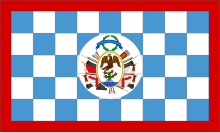
The Amelia Island affair was an episode in the history of Spanish Florida.
The Embargo Act (1807) and the abolition of the American slave trade (1808) made Amelia Island, on the coast of northeastern Florida under Spanish rule, a resort for smugglers with sometimes as many as 150 ships in its harbor.[1] In June, 1817, Gregor MacGregor, a Scottish adventurer styling himself the "Brigadier General of the United Provinces of New Granada and Venezuela, and General-in-Chief of the Armies of the Two Floridas",[2][3] came to Amelia Island. A peripatetic military adventurer, MacGregor, purportedly commissioned by Simón Bolívar,[citation needed] had raised funds and troops for a full-scale invasion of Florida, but squandered much of the money on luxuries. As word of his conduct in the South American independence wars reached the United States, many of the recruits in his invasion force deserted. Nonetheless, he overran the island with a small force, but left for Nassau in September.

His followers were soon joined by Louis-Michel Aury, formerly associated with MacGregor in South American adventures,[4] and previously one of the leaders of a group of buccaneers on Galveston Island, Texas.[5][6][7] After assuming control of Amelia,[8] Aury created an administrative body called the "Supreme Council of the Floridas",[9] directed his secretaries Pedro Gual Escandón and Vicente Pazos Kanki to draw up a constitution,[10] and invited all Florida to unite in throwing off the Spanish yoke. For the few months that Aury controlled Amelia Island,[11] the flag of the revolutionary Republic of Mexico was flown.[12] This was the flag of his supposed clients who were still fighting the Spanish in their war for independence at the time. The United States, which had plans to annex the peninsula, sent a naval force which captured Amelia Island on December 23, 1817.[13] In his December 2, 1817, message to the 15th United States Congress, President James Monroe described the affair as "a mere private, unauthorized adventure":
Projected and commenced with an incompetent force, reliance seems to have been placed on what might be drawn, in defiance of our laws, from within our limits; and of late, as their resources have failed, it has assumed a more marked character of unfriendliness to us; the island being made a channel for the illicit introduction of slaves from Africa, into the United States, an asylum for fugitive slaves from the neighboring states, and a port for smuggling of every kind.[14]
References
- ^ James Willard Milgram (July 1961). "A Florida Cover under American Occupation of Spanish Territory". Florida Historical Quarterly. 40 (1). Florida Historical Society: 94. JSTOR 30139819.
But beginning with 1808, because of Jefferson's Embargo Act, [[[Original Town of Fernandina Historic Site|Fernandina]] became a thriving port with more business than even St. Augustine. The reason was that from it, merchants had easy access to the states and smuggling became a most profitable business. At one time it was stated that there were more than 150 ships in the harbor.
- ^ Landers, Jane (2011). Atlantic Creoles in the age of revolutions (Reprint ed.). Cambridge, Mass.: Harvard University Press. p. 131. ISBN 9780674265288. Retrieved 26 May 2022.
- ^ "H. Doc. 15-47 - Message from the President of the United States, communicating information of the troops of the United States having taken possession of Amelia Island, in East Florida. January 13, 1818. Read, and ordered to lie upon the table". GovInfo.gov. E. De Krafft. 13 January 1818. p. 20. Retrieved 28 June 2023.
- ^ John Quincy Adams (1875). Memoirs of John Quincy Adams: Comprising Portions of His Diary from 1795 to 1848. J.B. Lippincott & Company. p. 75.
- ^ Natalie Ornish (1 September 2011). Pioneer Jewish Texans. Texas A&M University Press. p. 17. ISBN 978-1-60344-433-0.
- ^ David G. McComb (1 January 2010). Galveston: A History. University of Texas Press. pp. 43–44. ISBN 978-0-292-79321-7.
- ^ Frank L. Owsley; Gene A. Smith (22 March 2004). Filibusters and Expansionists: Jeffersonian Manifest Destiny, 1800-1821. University of Alabama Press. p. 136. ISBN 978-0-8173-5117-5.
- ^ James L. Erwin (2007). Declarations of Independence: Encyclopedia of American Autonomous and Secessionist Movements. Greenwood Publishing Group. p. 47. ISBN 978-0-313-33267-8.
- ^ David Head (1 October 2015). Privateers of the Americas: Spanish American Privateering from the United States in the Early Republic. University of Georgia Press. p. 107. ISBN 978-0-8203-4400-3.
- ^ Judith Ewell (1996). Venezuela and the United States: From Monroe's Hemisphere to Petroleum's Empire. University of Georgia Press. p. 250. ISBN 978-0-8203-1782-3.
- ^ Rafe Blaufarb (2005). Bonapartists in the Borderlands: French Exiles and Refugees on the Gulf Coast, 1815-1835. University of Alabama Press. p. 250. ISBN 978-0-8173-1487-3.
- ^ Richard G. Lowe (July 1966). "American Seizure of Amelia Island". The Florida Historical Quarterly. 45 (1): 22. JSTOR 30145698.
- ^ British and Foreign State Papers. H.M. Stationery Office. 1837. pp. 756–757.
- ^ "S. Doc. 15-1 - Message from the President of the United States, to both Houses of Congress, at the commencement of the first session of the Fifteenth Congress. December 2, 1817. Printed by order of the Senate of the United States". GovInfo.gov. Edward De Krafft. 1817. p. 5. Retrieved 27 June 2023.
